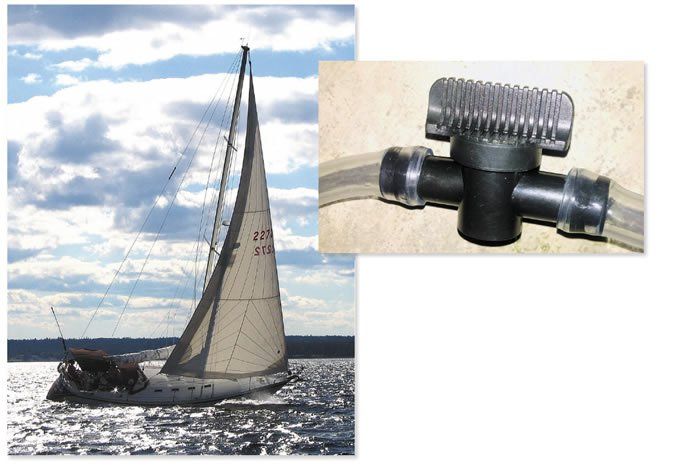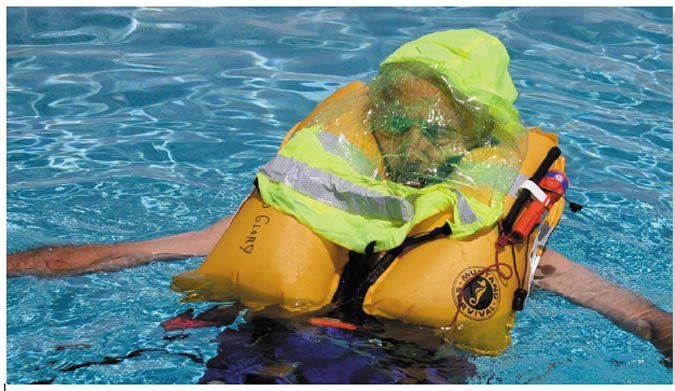
Fuel Overfill Protection
In response to your December 2015 article on fuel overfill prevention devices: After my own frustrating experiences with fuel spills when using jerry cans at sea and at anchor, I have been using a shaker siphon for several years. However, the handling of the siphon afterwards always resulted in some dripping, and the twistiness of the tubing added to the problem.
One addition I added was a stopcock about one foot from the supply end. I purchased the half-inch stopcock at a local hydroponics shop for about $6. It functions as a means to hold the tubing in place in the fill pipe, to control flow, and when in the closed position, it allows handling of the siphon tubing without any drips.
Robert Prange
Eau de Vie, CS 36T
Mahone Bay, Nova Scotia
Canada
Fuel Additive Feedback
We thank Practical Sailor for the correction to the article Additives vs. Gum, Sludge in your November 2015 issue. [To read the correction, see Mailport in the January 2016 issue; the original articles online version has been updated with the new content.]
Gold Eagle Co. is the industry leader in gasoline fuel stabilizer and ethanol treatment additives under our Sta-bil brand, which has been recommended by Practical Sailor for many years, including the following articles: November 2008, additives for ethanol, Sta-bil Marine Ethanol; August 2012, E-10 additives that fight corrosion; November 2012, E-10 additives that fight corrosion (updated); August 2013, diesel additives that fight corrosion.
In regards to this most recent article, we appreciate Practical Sailors recommendation, but feel that your view of Sta-bil brand products would be far more positive had the author: 1) tested our Sta-bil Marine 360, which is a better performer in corrosion prevention than our ethanol treatment product because it is designed specifically for the marine environment; and 2) used the only petroleum industry-recognized gasoline stability test, ASTM D525. When using this industry standard test, Sta-bil brand additives far exceed petroleum industry fuel stability standards. The use of the diesel stability test, ASTM D4625, results in a false positive for gum and varnish formation. Sta-bil brand products contain a high percentage of soluble particulates like anti-corrosives and detergents that look like gum and varnish in the test.
We look forward to our continued relationship with Practical Sailor as we work together to serve your readers and the marketplace. We will continue to manufacture leading products that will help PS readers enjoy their hobby and protect their investments.
Tom Bingham
Senior Director of Marketing
Gold Eagle Co.
www.goldeagle.com
Clear Vinyl Cleaners
Regarding your article on clear vinyl cleaners and polishers (PS January 2016): I have used the Camco Armada 210 aerosol on my dodger windows for the past eight years with no ill effects. It keeps the dodger windows clear, clean, and transparent. After polishing, the slippery surface sheds water, salt, and dirt. I am careful to keep the spray off the dodger canvas, so I cannot say what happens if that precaution is not taken. I am very happy with the 210 product. I recommend it and intend to keep on using it.
Len Thibodeau
Breakaway, 1981 C&C40
Marblehead, Mass.
Spiders vs. Wind Sensors
Ive been considering switching to an ultrasonic wind sensor for several years, and I found the Maretron WSO 100 test (see PS March 2015 online) very helpful. However, it did not address one of my biggest concerns: Ive always wondered if spiders and their webs would compromise the performance of the sensor. More specifically, would the accumulation of debris in any webs in the sensor housing cause the unit to malfunction? Being located at the top of the mast obviously makes routine cleaning of the unit impractical.
Ed Garr
Namaste, Island Packet 32
Erie, Penn.
With ultrasonic wind sensors, sound is emitted from one sensor (the speaker) and carried to another sensor (the microphone) by the wind or air movement. If the air movement is hindered (by spider webs, leaves, or other debris caught in the web), then the wind speed is also impeded, and the true wind speed is not being reported. According to Maretron, a few spider webs are not going to significantly alter the wind speed through the unit, but a highly built up web and its associated debris will create problems. Fortunately, it doesn’t appear that the top of a mast is the best place to build a spider web, and we have had no reports of problems associated with spider webs, explained Maretrons Rich Gauer.
Be sure to check out all three parts of the Reading the Wind wind-sensor test series (see PS August 2014, May 2014, and March 2014 online).
Sail vs. Shaft Drives
In the December 2015 Mailport, you made some excellent comparisons between sail and shaft drive systems. However, you overlooked the issue of maneuvering at slow speeds, such as in docking at speeds of 1 to 2 knots. Prop wash, particularly in reverse, leads to sluggish responses in sail drive installations in larger boats, while the proximity of the prop wash relative to the rudder in shaft drives provides much quicker responses, thus minimizing dock rash incidents.
Dr. Charles F. Barth
C&C 37 TR
Lorain, Ohio

High-Visibility Colors
In the June 2015 Mailport, you said recent visibility studies show fluorescent green is more visible . . . The Coast Guard did some extensive testing after World War II on color visibility from a search-and-rescue standpoint, and they found that vivid reddish-orange was the most visible at sea, if my memory serves. They did not have the bright fluorescent colors we have today, but in the 80s or 90s, some delegation suggested fluorescent green at the International Maritime Organization meeting to replace the widely used international orange. When pressed for more information, they provided results of a study done for highway crews. There had been no work done at that time against marine backgrounds. Consequently, the suggestion was not adopted.
I am not aware of any comprehensive maritime environment color visibility studies since that vintage Coast Guard work. If there are recent, well-designed studies of highly visible colors in the maritime environment, they would be very interesting to see or to summarize in your fine publication.
Bob Markle
Radio Technical Commission for Maritime Services
Arlington, Va.
We are working on an in-depth report on which colors are most easily detected on the water for an upcoming issue. The study that prompted our report was recently carried out by marine safety gear maker Mustang Survival (www.mustangsurvival.com) and sponsored by the Canadian governments WorkSafeBCs Research Secretariat program (www.worksafebc.com). That study, conducted in a lab and on the water, found that fluorescent green was more visible than standard oranges, reds, and yellows in a marine environment, particularly in low-light conditions. Mustang has incorporated the findings into its safety gear, with its newer inflatable PFDs featuring fluorescent-green bladders (rather than the previous yellow-orange bladders); several other manufacturers, including Spinlock, already use fluorescent-green fabric in PFD spray hoods or the hoods on foul-weather jackets.
We highly recommend watching the related video on Mustangs website (http://www.mustangsurvival.com/blog/2015-06/what-most-visible-color-can-be-worn-when-water?country=25);


































